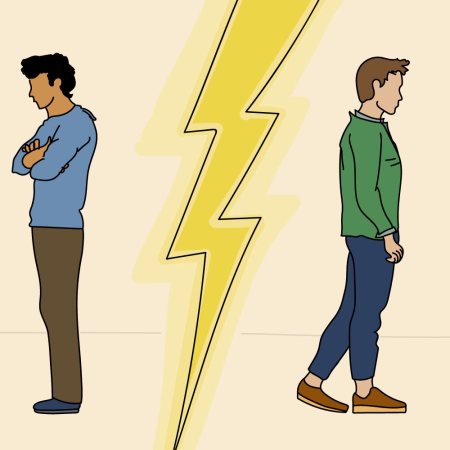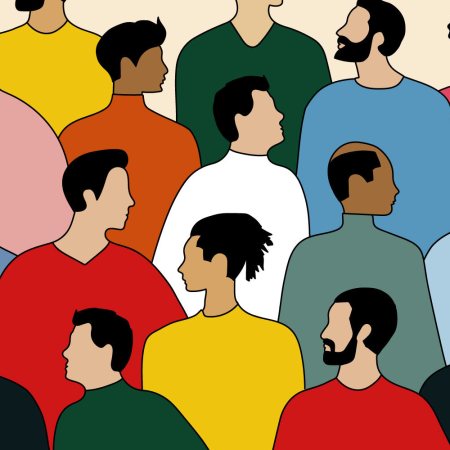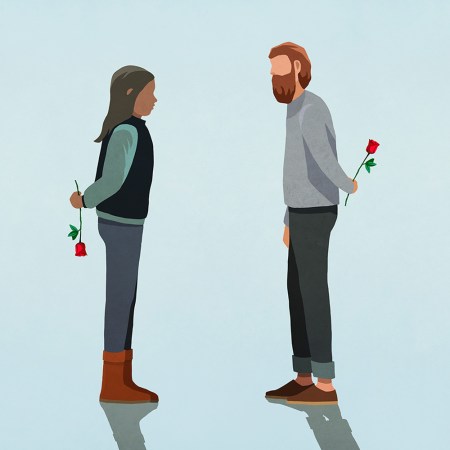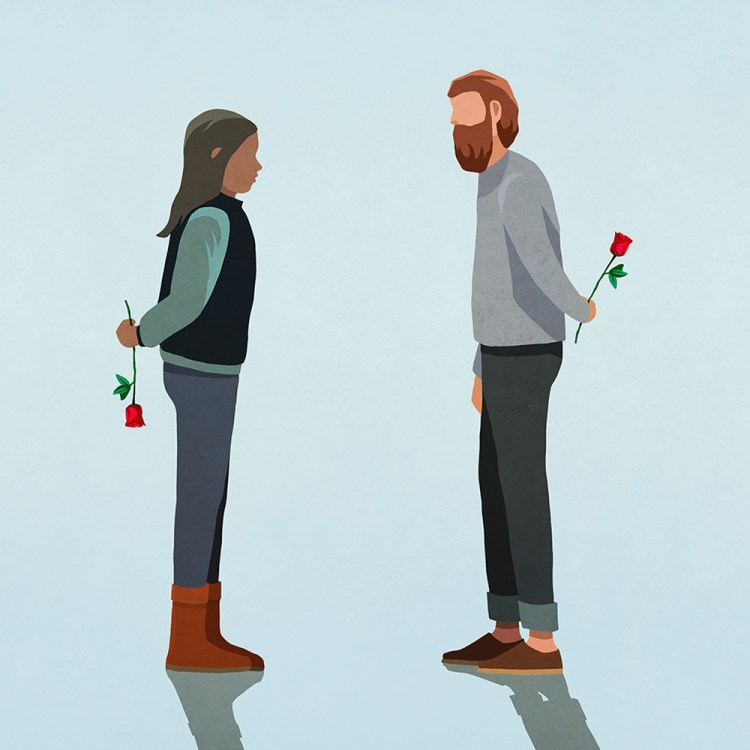During the last decade, ethical non-monogamy (ENM) went from a taboo topic to a highly visible — and, in some areas, borderline mainstream — relationship structure. In late 2022 alone, an American politician came out as non-monogamous, at least one celebrity openly voiced an interest in ENM and dating app Hinge made it easier for people to identify as non-monogamous, which many promptly did. Discussions of ENM life and dynamics are all over Twitter and TikTok. Trend pieces dissecting its popularity and prevalence are a dime a dozen. And a few surveys suggest that upwards of one in five people in the United States and Canada have at least dabbled in ENM.
Yet, most popular depictions of ENM have been — and remain — narrow and problematic. Talk shows and reality TV historically put the focus on polygamous arrangements in which a man married many women who didn’t (openly or officially) form relationships with each other. Recent coverage of ENM may have moved beyond that fixation, but it still tends to focus on “triads with two bisexual women and one man” who’re all in relationships with each other but not with anyone else, notes Leanne Yau, the founder of Poly Philia, an ENM education and content hub. “In reality, that’s a very small percentage of the polyamorous community.”
Even deep dives on the wide world of ENM only make cursory nods towards other types of non-monogamous relationship dynamics. And all too often, pop culture still portrays anyone who’s non-monogamous but not in a closed triad as simply commitment-avoidant and promiscuous — which is a far cry from what ENM actually looks like for most people. “Most of us cringe at polyamory in the media,” says Morgan K. of chillpolyamory, another ENM education hub. “Monogamous writers see us as a vehicle for sexual fantasies and cautionary tales.”
In reality, ENM is an umbrella term encompassing any individual approach to relationships, intimacy and any sexual or romantic dynamic that forms between two or more people that goes beyond traditional monogamy — so long as it’s openly, clearly expressed and consensual. “Non-monogamy is…not a cohesive community, or even a single ideology — we are not a monolith,” Morgan K says. “If someone tells me they’re non-monogamous, that prompts me to ask several dozen more questions before I can understand what that even means for them.”
People have developed a staggering array of new terms to describe these diverse orientations and styles. Deciphering this vast vocabulary “can be overwhelming,” Yau admits, especially for ENM newcomers and outsiders. (After a decade spent practicing and learning about ENM, I still occasionally stumble on new terminology.) And whenever ENM advocacy and education groups try to create simple guides to this vocab, they often overstuff them with super niche entries, yet also under-define key terms, assuming a bit too much reader knowledge. Ultimately, these insider cheat sheets are often still difficult for the average person to engage with and or even find in the digital wild.
To help the uninitiated develop a more comprehensive understanding of diverse ENM dynamics and the unique terminology that surrounds them, we put together a concise yet comprehensive field guide to the types of ethical non-monogamy. We reached out to about a dozen well-known and highly experienced ENM practitioners and educators, and poured over a dozen ENM guides and resource hubs to ensure it’s as accurate and nuanced as possible while still being accessible to complete ENM outsiders.
A Word of Caution
Although people have always practiced diverse forms of ENM, the language we’re about to throw at you is relatively new. Even the term ENM only originated circa 1990 and gained broad visibility via the 1997 book The Ethical Slut. “Terms can shift and change at a dizzying pace,” says Dedeker Winston, the host of the Multiamory podcast and author of the 2017 book The Smart Girl’s Guide to Polyamory.
There’s actually an ongoing debate among activists and educators about whether people should stop using ENM as an umbrella term and instead use “consensual non-monogamy” or just “non-monogamy.” InsideHook is using ENM in this article because, for now, it is arguably one of the most widely recognized terms for the sort of relationship dynamics we’re discussing.
Even when people do agree on the definition of a given term, static labels are inherently limited in their ability to describe complex, ever-shifting relationships in practice and motion. “Every person who practices ENM does it slightly differently,” says Dr. Liz Powell, an educator and therapist who specializes in non-monogamous relationships. “Part of the beauty of ENM is the ability to let go of relationship scripts and find what works for you.”
Regardless, ENM terms help us talk about diverse and complex experiences. But you should always take the definitions in guides like this with a grain of salt, and certainly never as prescriptive guides for how someone else must practice a given type of non-monogamy. And you should always have conversations with people about what the labels they use mean to them if you really want to understand what non-monogamy looks like in their lives.
Polyamory
People sometimes use polyamory as a synonym for ethical non-monogamy, says Robyn L. Trask of the advocacy and education group Loving More. But while it’s also a widely-recognized umbrella term for several distinct types of non-monogamous relationship dynamics, it’s actually much narrower than the truly big-tent concept that is ENM. Polyamory literally means multiple or many loves, and thus specifically refers to an openness to the formation of more than one romantic relationship — characterized by a deep emotional connection — at a time.
Not all people who identify as polyamorous are actively in multiple romantic relationships. They can be single or involved with one person, but open to the prospect of forming one or more new relationships. But this openness to additional relationships doesn’t mean that polyamorous people are always seeking partners, nor are they necessarily having sex with multiple people, even if they have multiple loving relationships. There are asexual but still romantic people who form polyamorous relationships, for example. And sexual people can often form loving and committed relationships without sex with one or more of their partners.
But while all poly people share a belief in at least the possibility of finding and maintaining multiple romantic relationships, there are several distinct ways of approaching polyamory.
Hierarchical Polyamory
In this form of polyamory, people openly and expressly differentiate between primary, secondary and even tertiary partners based on the amount of time, support and general bandwidth they devote to each. They often give more weight or power to one partner’s wants, needs and opinions over others when making overarching relationship or life decisions, in accordance with their established place within a relationship hierarchy as well.
As with all things ENM, there are no hard rules — or even ubiquitous norms — about how a person can or should divide their time or energy between partners at different levels in a hierarchy. Some primary partners give each other veto powers, like the ability to tell each other to end a relationship with a specific secondary partner with no pushback, and give secondary partners no say in the nature of their relationship with other folks whatsoever. But some poly people believe veto powers are unfair or even outright unethical and fundamentally toxic, and that everyone involved in a dynamic should have some say in its overall shape.
People often assume there’s only room for one primary partner in a hierarchy, and that this is the person someone may end up cohabitating with or marrying. But it’s possible (albeit not very common) to have two or more primary partners within one hierarchical structure. Some people also don’t follow the relationship escalator, the process of measuring and marking the intensity of a relationship by life-merging milestones such as marriage or joint home ownership. So they may choose to, say, cohabit with a secondary partner for practical reasons, while still devoting more time, energy and relationship power to one or more primary partners they don’t live with.
Non-Hierarchical Polyamory
While this form of polyamory rejects the explicit stratification of partners — and the idea of one partner holding power over other relationships in a given dynamic — it doesn’t necessarily involve the creation of strictly equal relationships. Non-hierarchy poly people simply approach every connection they form as its own distinct thing, and let it “develop into whatever works for the people involved,” Powell says. A person may end up spending more time with one partner than with others, especially if they end up cohabitating. But they will still try to take all their partners’ wants and needs into equal consideration.
Powell likens this sort of relationship structure to a friend group. “People in the group may have closer connections to some fellow group members than to others,” they say. “But they are each relating to the other people in the group as individual people.”
Solo Polyamory
While this term has grown more visible during the last year or two, the experts we spoke to all agree it’s still perhaps the least known or understood form of polyamory. It’s often described as a relationship structure in which a person is their own primary partner, prioritizing self-care over traditional relationship enmeshment. But that’s not quite right, and it often fuels the idea that solo poly people are “commitmentphobes who are selfish and avoidant and don’t really love anyone,” Yau says. “Solo polyamorous people reject the idea that, if you love someone, you need to live with them. You need to put a ring on it. They reject the idea of coupledom and the fact that we all need to be paired off to create the nuclear family with 2.5 kids.”
That’s not to say that other poly people embrace every aspect of traditional coupledom; many don’t. But solo poly people are so stringently against traditional coupling that they draw hard lines in relationships and carve out time and space specifically for the maintenance of their independent lives. This is distinct from single polyamory, a term that describes a poly person who’s just not in any relationship now. A single poly person may be inclined or open towards any type of polyamory.
Polyfidelity
Also known as a closed marriage group or a closed polycule. It refers to a group of poly people who are all in committed and exclusive relationships with each other and who only bring a new person into their circle with the enthusiastic consent of everyone involved. This commitment may take the form of everyone in a polyfidelity dynamic dating each other (a circle), of one person dating two people who don’t date each other (a vee) or any other number of direct relationship permutations, each described by a corresponding shape.
Usually, every member of this closed unit will be equal to each other, and thus there is overlap between polyfidelity and non-hierarchical polyamory. But this is not always the case. People also often equate polyfidelity with the concept of a thruple or a quad, some of the most commonly depicted forms of non-monogamy in modern media. But not all thruples, quads and so on are totally closed off to outside partners. They may just be a core relationship unit that remains open, allowing members to go out and pursue casual flings or form external relationship dynamics.
Polygamy
A dynamic in which one person (usually a cis-het man) marries multiple people who typically do not have relationships with each other and defer most life and relationship decisions to the partner at the center of these marriages. Also known as plural marriage, this type of relationship is sanctioned or encouraged in some cultures and religious traditions, including early Mormons and modern-day breakaway Mormon fundamentalists in America. Until relatively recently, it was perhaps the best known form of non-monogamy. However, there is not a great deal of connection between polygamous groups and modern ENM advocates.
Open Relationships
This describes dynamics in which people have one or more committed, romantic partners but have express permission from their partner(s) to pursue sex outside of their relationship structure. (It’s important to remember that not all non-monogamous relationships are open!) Different forms of open relationships put different limits on when, how and why someone can pursue intimacy outside of their core relationship. But most put hard limits on the level of intimacy people can develop with extracurricular sexual partners.
Some people adopt a “don’t ask, don’t tell” policy, under which they don’t share any details with their partner(s) if or when they exercise their mutually-agreed rights to sex outside of their relationship. This is often framed as a means of avoiding jealousy or discomfort. But given ENM’s focus on open and explicit communication, many folks unsurprisingly view this sort of rule as a dangerous tact, bound to cause rather than avoid hurt feelings and misunderstandings.
Monogamish
The prolific sex and relationship advice columnist Dan Savage coined this term several years ago to refer to the surprisingly common practice among traditionally monogamous folks of opening up their relationships in response to specific conditions. This encompasses couples who accept that they can or will each sleep with other people if they’re away from each other for prolonged amounts of time. (Some relationships adopt the zip code rule: if members travel to different cities, they’re free to experiment. Others only open up in the case of a long-term, long-distance relationship.) They could also up their relationships to outsiders for threesomes or kink play, in either one-off or ongoing but clearly-restricted encounters. Or they give each other a hall pass to sleep with one or a small set of people they’re especially attracted to if the chance arises.
Some monogamish situations can involve frequent sexual interaction with the same partner that may start “to appear like polyamory,” notes Elisabeth “Eli” Sheff, a sociologist and relationship coach who specializes in non-monogamous dynamics. But no matter the context, a monogamish person’s committed partner(s) will always “take primacy over other relationships,” she says.
Swinging
This is a distinct non-monogamous lifestyle that developed in the mid-20th century, which usually involves committed couples swapping partners with each other. Some couples only engage in soft swaps, which allow most types of sexual play with someone else’s partner but draws a line at penetrative sex, while others engage in full swaps. Some swaps occur in the same room while others occur in separate rooms. Usually, swinging swaps occur at dedicated parties or venues like resorts or on couple-couple dates, with strict codes of conduct laid out specifically to avoid the development of romantic feelings or independent intimate dynamics outside of a person’s core, monogamish relationship. Some couples who swing with each other often can grow incredibly close as a foursome but still try to maintain limits on entanglements.
This type of open relationship seems to be on the decline, likely because the particular cultural context that gave birth to it has passed and there is now a far wider constellation of ENM approaches and communities for people to join. But emerging ENM groups sometimes borrow swinging language, which can be confusing to those familiar with this form of non-monogamy. “The term in the lifestyle comes from the swinger community,” Wright says. “But people are starting to use it on dating profiles to mean I’m in a polyamorous lifestyle.”
Is Your Open Marriage Any of Your Kid’s Business?
The pros and cons of talking to your children about your non-monogamyCasual Dating
This is arguably one of the most traditionally socially acceptable forms of non-monogamy, to the point that some people don’t even see it as a type of ENM. It describes folks who haven’t formed at least one committed relationship but who go out on one or more dates with many people, often building limited bonds and ongoing sexual relationships with multiple partners. Sometimes, people date casually with an eye to finding one committed partner for whom they’ll cut off all their other intimate dynamics. But other folks date around to find connection and pleasure without seeking a dedicated relationship.
Ideally, in an ENM framework, people who’re casually dating will be upfront with everyone they get involved with about the fact that they’re seeing or hoping to see other people at the same time. But in practice, people who date casually often take the limited level of commitment they’ve established with their partners as an excuse or form of permission to do whatever they like without considering, consulting or notifying anyone they’re involved with.
Friends with Benefits
This is a well-known term, yet one with a somewhat wobbly definition. It can refer to people with an established platonic friendship who decide to add a sexual component but don’t want to form a committed and emotionally intimate relationship. Or it may refer to two individuals with no prior connection who decide to form an ongoing sexual relationship (i.e., to become fuck buddies) that is expressly not intended to evolve into an exclusive and/or romantic entanglement. Some friends with benefits dynamics are closed, but most are open to at least some degree. They may also form parallels to or within a wider relationship dynamic. Someone in a monogamish relationship may form an ongoing FWB dynamic while living apart from their coupled, romantic partner, for example. But whatever the specifics of the situation, this form of (typically) non-monogamy usually describes a particular blend of consistent sexual contact and meaningful but limited, non-romantic connection.
Relationship Anarchy
Sheff calls this “the least known and understood” form of non-monogamy. “It sounds terrifying to most people, like a free-for-all with no boundaries,” she adds. Outsiders often do describe it as a dangerous do what thou wilt, no-labels approach to sex and intimacy — the key manifestation of free-wheeling stereotypes of promiscuous non-monogamists.
The reality is nothing nearly so unruly. Coined in the mid-aughts in a manifesto authored by the Swedish activist Andie Nordgren, it applies intellectual anarchist philosophy to relationships. At its core, relationship anarchy rejects the elevation of some forms of relationships over others, including the idea that romantic or sexual relationships are more important than platonic friendships. It advocates for treating every connection with another person as a unique bond and for consciously negotiating and cultivating a bespoke dynamic with every person or group one grows close to. Often, relationship anarchists try to place as few rules or restrictions on those they’re involved with as possible, Powell says, while still attempting to recognize and respect emotional and physical wants, needs and boundaries.
Relationship anarchy is such a flexible, contextual approach to relationships that it resists easy classification alongside or comparisons with other forms of ENM. One person following RA approaches might end up in a dizzyingly complex constellation of relationships, while another might develop “some very traditional-appearing boundaries,” Sheff says, that almost look conventionally monogamous from the outside. But the person who seems like a relationship anarchist’s primary partner may, for example, actually be someone they’re not sexually or romantically involved with, but they’re lives are enmeshed anyway.
Other Useful Terminology
Ambiamorous
This term describes people who may shift from practicing traditional monogamy, to opening up their relationships, to practicing some form of polyamory — and back and forth between these styles — depending on who they’re with or where they are in life.
Polycule
This term describes the complex webs that often form between people who practice non-monogamy, which often look like illustrations of complex molecules’ atomic structure. Depending on how far out you look (do you include one partner’s casual, conditional, occasional hook-up, for example), these webs can grow incredibly broad and complicated. But there is no set rule about who to include when describing or diagraming out a polycule. It’s an intentionally flexible term.
Comet
A partner one only sees infrequently, often because of distance or busy schedules. Although people frequently view comets as casual sexual partners, they may still form close emotional bonds.
Polysaturation
A term for the limits on how many relationship dynamics a person can balance all at once. In some cases, these limits are semi-arbitrary, perhaps set by a primary partner in a hierarchical polyamorous relationship. In other cases, people stumble upon their polysaturation line when they realize they don’t have the bandwidth for any additional partners. It may be hard to tell where the line of polysaturation is for an individual (as we all have more bandwidth at some points in our lives than others), as not every relationship requires the same amount of time and physical or emotional energy to maintain it well.
Metamours and Telemours
A metamour, sometimes shortened to a meta, is a term for one of your partner’s consistent romantic and/or sexual partners who you know or know of, but with whom you are not also romantically or sexually involved. Some people do form friendships with metas, Powell says, or wish to form relationships with them eventually. (Some folks call metas they’re attracted to metamorsels.) A telemour is a meta’s partner who is not involved with you or the partner through whom you know a meta. They are, in other words, part of a polycule web, but a spoke in the network that doesn’t tie directly back to you and/or your partner(s).
Parallel, Garden Party and Kitchen Table Polyamory/Non-Monogamy
These terms describe differing levels of closeness between members of a polycule. In parallel dynamics, two partners may be open and enthusiastic about the fact that they form relationships with other people, but they don’t want to hear about or interact with those individuals. All of their relationships play out strictly parallel to each other, rather than intersecting. In garden party dynamics (also known as birthday party polyamory or non-monogamy), two partners know about and occasionally interact with each other’s extended partner networks. However, while friendly, they may not be close with these metamours and telemours. In kitchen table dynamics, most (if not all) people in a given polycule know each other, interact often and even form supportive friendships.
Anchor/Nesting Partners
This term describes two partners who’ve decided to intertwine their lives in ways associated with traditional monogamous relationships, like via marriage, home ownership, joint financial arrangements and child rearing. However, the term avoids the sense of hierarchy that usually comes with referring to this individual as a primary partner. It reflects non-hierarchical relationship values and approaches and the fact that the trappings of a traditional exclusive relationship don’t always accord with traditional relationship structures.
Monocorn
A term for a (mostly) monogamous person who’s open to dating a non-monogamous person. They often actively support and encourage their partners in additional relationships but expressly do not harbor any interest in pursuing other relationships themselves. People often assume that monocorns are asexual, into cuckolding or have some other very specific motivation or rationale for their openness to this seemingly imbalanced relationship dynamic. But some people simply like who they like and are comfortable rolling with whatever works for them.
Unicorns and Unicorn Hunters
The term unicorn emerged, seemingly as a joke, to describe a very particular type of partner that many cis-hetero monogamish couples seem to seek when they want to explore threesomes, certain types of kink play and the like. Usually, it refers to a cis, bisexual woman who’s open to parachuting into a couple’s relationship for one night only or on limited occasions. (Some people refer to these women as hot bi babes, or HBBs.) The idea is that these individuals will not favor one cis-hetero partner or another and won’t be around long enough for anyone in a monogamish situation to develop complicated feelings.
Many ENM activists and educators talk about unicorn hunting, the act of seeking out these folks, as a red flag behavior, as it often centers on what a couple needs from an ideal temporary partner — who they may treat more as a fantasy object than a person — than it centers on everyone’s wants and needs. Unicorn hunters also tend to haunt dating apps, matching people without making their desires clear and then propositioning them out of the blue in ways that feel a bit predatory. But Wright points out that some people do enjoy acting as unicorns for couples and that there are considerate and caring ways to seek out and relate to these people (like to seek a third for a night).
Cowboy/Cowgirl/Cowpoke
These are the male, female and gender neutral terms for a person who gets involved with a non-monogamous person, either claiming that they practice or are open to ENM themselves or presenting as a monocorn, then tries to lasso them or someone in their polycule into a traditional monogamous relationship instead. This process is often associated with guilting, gaslighting and other forms of manipulation meant to subtly shame someone into second-guessing their relationship preferences, gradually aligning them more with the cowpokes.
Troller
A term for people who join ENM circles, or present themselves as thoughtful non-monogamy practitioners on dating apps, but who are in fact just looking for strings-free sex.
Whether you’re looking to get into shape, or just get out of a funk, The Charge has got you covered. Sign up for our new wellness newsletter today.















